|
Champion's Choice
John Brewer's Nat'l Championship-Winning F-Classer
Other Guns of the Week >
It's a rare opportunity to showcase the firearm of a reigning National Champion. This week we feature the 6.5-284 of John Brewer, winner of the U.S. National F-Class Championship in October, 2004. John, a member of the U.S. F-Class Rifle Team, will soon depart for South Africa to compete in the World F-Class Championships. John was kind enough to interrupt his busy schedule to tell us about his rifle and share his thoughts about 6.5-284s, 6BRs, F-Class, and the future of long-range competitive shooting.
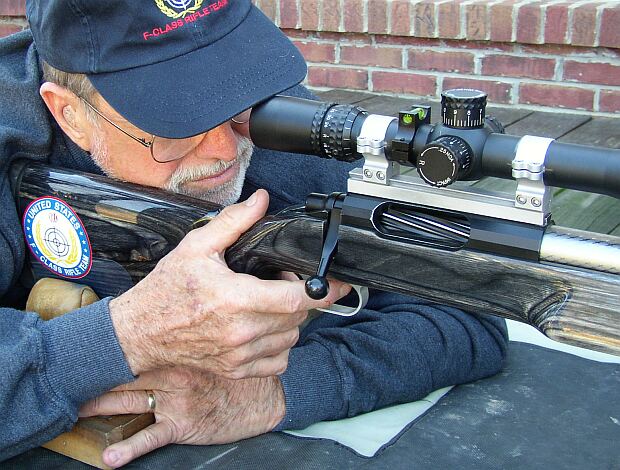
73-year-old John Brewer's victory in the 2004 U.S. National F-Class Championships earned him a spot in the pantheon of great American long-range shooters. Jumping out to an early lead (by shooting a 6BR at 600 yards), John hung on through a blustery third day to take the crown with a 1277.79 score. (In this match Xs counted 11 points). Right behind John were his close friends (and fellow "Senior Shooters") Larry Bartholome and J.J. Conway. Larry and J.J. actually finished with the exact same 1269.74 score, but Larry was awarded second place based on Creedmore Rules.
What does it take to out-shoot many of the nation's best marksmen in a three-day match? Well it takes lots of practice, great wind-reading skills, superior loads, and a gun that can hold Benchrest levels of accuracy through long strings of fire. The heart of John's gun is a black Stolle Panda action. John swears by Pandas, explaining "Kelbly controls Panda tolerances so well that I can just call up a smith and he can prepare a perfectly chambered and headspaced barrel without ever seeing the action. This is very important when you shoot a barrel-burning caliber like the 6.5-284." The barrel in the photos is a 28" heavy-contour Schneider P5 Polygon 1:8.5" twist, with signature "Spider Web" finish by Speedy Gonzales, who also smithed this gun. John told us, "The Schneider P5 is the barrel with which I won the National Championship and it is the most accurate barrel I've shot in 6.5-284--and I've had at least a dozen". However, in the upcoming World Championship match, John will use a Krieger cut-rifled barrel, simply because his pre-loaded ammo was optimized for the Krieger. The stock is a Shehane MBR Tracker in smoke laminate. Like many top long-range competitors, John uses a Nightforce 12-42x56 NXS scope (his prize for winning the Nationals). Rings are by Kelbly and the trigger is, as you might expect, a Jewell.
Standards of Accuracy and Load Development
John does almost all his serious load work at 300 yards. He's not satisfied unless the load will group from 1.0-1.25" for ten shots at 300. That level of accuracy, he feels, is what it takes to win these days. He adds, "I don't shoot a single test round that doesn't go through my Oehler 35P chrono. Because I'm not just going for a little group. A little group at 300 yards isn't enough if I don't have a good standard deviation. I like to see 4-5 fps Standard Deviation (SD) with Extreme Spread (ES) in the 'teens. Usually my ES is in the low 20s or better for ten shots." Though John works at 300 yards most of the time, he says you better have a load that works at 100 yards first. He thinks the notion that some bullets need two or three hundred yards to "go to sleep" is wrong: "If you can't get itty-bitty groups at short range you sure as heck won't get good groups at long range."
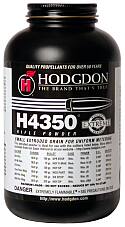 Match Loads from the Brewer Master Match Loads from the Brewer Master
John uses a variety of barrels on his 6.5-284 F-Classer. He's found that the optimal load varies with the barrel, and the powder lot. In his 6.5-284 he uses Hodgdon H4350, in a range from 48.5 to 49.3 grains. This yields about 2950 fps, with ES in the low 'teens and SD of 5-6 fps. He sets his bullets (naked 142gr Sierra MKs) .020-.025" in the lands, using about .003" neck tension. We asked John if he'd ever tried jumping the bullets, which seems to work for many 6.5-284 shooters. John replied: "Haven't tried it--no new tricks for this old dog I guess...."
When shooting with the U.S. F-Class team, John uses his 6.5-284 exclusively. (Having all team members shooting the same caliber makes it much easier for the coaches to make wind calls on the firing line.) But when competing on his own, John often shoots his 6BR at 600 yards because he feels it is inherently more accurate than the larger caliber. John reports: "At 300 yards, the 6BR delivers consistent 1" ten-shot groups, with almost no vertical--that's awfully hard to match with my 6.5-284". John's 6mm BR load is 31.3 grains of Vihtavuori N540, pushing 107gr molyed Sierra MKs. This yielded about 2960 fps with an earlier 28" Kreiger barrel, and generates 2920 fps with the current 28" Kreiger. His 6BR has a .272" no-turn neck (Kiff reamer), and he runs about .003" neck tension with the bullets in the lands.
Comparing the 6.5-284 with the 6BR
John tells us: "Among the calibers I shoot, the 6BR is the easiest to load for, and the easiest to shoot. I can free recoil the 6BR if I like. The gun shoots incredibly well, and I think it's actually pretty hard to get a bad 6BR load--the cartridge works with many different powders and bullets. Plus my 6BR gives twice the barrel life of my 6.5-284. Even at 1000 yards, comparing the 6.5-284 and the 6BR, my scores would probably be the same, as long as conditions are favorable. In good conditions, I think the 6BR can beat any thing at 1000. But you don't see those good wind conditions often enough. So that's why we turn to the bigger calibers and higher BC bullets. But many members of the F-Class team are now looking at moving down to 6mm, now that the new 115gr Tubb bullet looks so promising. The goal would be to get longer barrel life than the 6.5-284, with equivalent long-range ballistics."
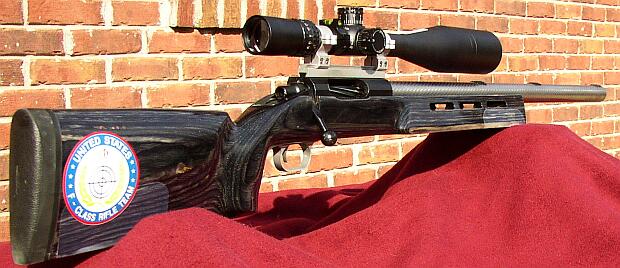
John Brewer Talks about Precision Shooting
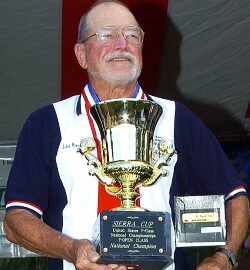 Editor: John was gracious enough to chat with me at some length, despite being very busy preparing for the Worlds. We covered a myriad of topics--from the Great Moly Debate to the mysteries of mirage. As expected, John had a wealth of knowledge to share. I began by asking him about his background in the shooting sports, and the path that led to his National Championship: Editor: John was gracious enough to chat with me at some length, despite being very busy preparing for the Worlds. We covered a myriad of topics--from the Great Moly Debate to the mysteries of mirage. As expected, John had a wealth of knowledge to share. I began by asking him about his background in the shooting sports, and the path that led to his National Championship:
John Brewer: My competitive shooting career began in 1960 in Port Huron, Michigan when I discovered the sport of NRA High-Power. A lot of moving kept me from shooting for a few years but I was able to start competing regularly with a service rifle in the early 1980s. I got my Distinguished Rifleman's Badge in 1989 and made the President's 100 at Camp Perry in 1992. I started shooting F-Class four years ago and had a great year in 2004, winning the Tennessee State Championship and National Championship.
Q: If you could name one factor that contributed most to your victory at the Nationals, what would that be?
The rifle was just shooting awesome. It had no elevation. One day in the individual match I had 15x. I had easy wind, we didn't have much wind at all. I don't normally do as well when it's real windy or blowing erratically, as is often the case at Raton. Larry had the best score on the last day when the winds were more tricky. I came in fifth on the last day, but I had racked up enough points on Day 1 and Day 2 to retain the lead--but not by much. Larry and J.J. were right there. Any one of us could have won the match. Keep in mind that J.J. is 80 years old!
My game plan was to shoot the 6BR at 600 yards on Day 1. That day the second-place finisher was Jim Murphy shooting a 6XC. I decided to go with the 6BR because, as far as I'm concerned, at 600yds my 6BR was more accurate. With the half-minute 3" X-ring, and with Xs counting 11 points, I wanted all the X-Rings I could get. In hindsight I think it was a good call.
Q: The next F-Class Nationals will be held at Oak Ridge, Tennessee. What will be your game plan for that match? Do you have any tricks up your sleeve?
Well, in 2004 we shot a half-MOA X-Ring target at 600 yards. That put a premium on pure accuracy--and that's why I used the 6BR. I think it's more inherently accurate at 600 yards than a 6.5-284. At Oak Ridge, we will be shooting full-size Palma targets at all distances, and temperatures will probably be hotter. I may change loads for the pressure. Before any match I shoot I ask myself, "What do I know of the range, when can I practice, what can I use for a barrel, what do I know about the wind, and what will be the game plan?"
Q: Even though the 600-yard target will be bigger at the 2005 F-Class Nationals, will you still shoot the 6BR at that range?
Yes, I will shoot the 6BR again at 600 yards. The Oak Ridge range doesn't have that much wind. I do better with less recoil and I think the 6BR will give me an edge. Hopefully I won't have to pray to the wind gods the night before.
Q. Is there a "Brewer Philosophy" when it comes to rifle shooting--a mental approach to the game? Or do you just handle it like any other tasks--pay attention to details, watch the conditions, and trust your equipment?
All the above. I try to shoot fast but I'll wait out condition shifts if possible. When we shoot in Team competition, I should note, the Team Captain makes the call whether to wait out the conditions or shoot through them. This is key. At a team match, there are eight shooters and a limited amount of time to shoot. When the wind gets squirrely the Team Captain has to make the decision--that's what wins these matches, not the shooters--it's the wind management.
Q: With the extremely high scores being shot in F-Class now, using the standard NRA long-range targets, do you think it's too easy to shoot clean?
Probably. But there aren't enough of us to have stand-alone F-Class matches, so we need to shoot along-side Palma and NRA High-Power shooters. We need to use the same targets for all shooters, or it would be much more difficult for the folks running and scoring the matches. However, I do think it's exciting to shoot the smaller targets. The Australians use a half-minute of angle X-Ring, while we shoot one MOA X-Rings. Smaller targets demand a different strategy. A 10" X-Ring at 1000 yards is pretty tough, but given today's scoped rifles, the 20" Ten-Ring is HUGE. As long as you can hang in those 20", you haven't dropped a point. You can be more cautious in your hold-offs so as not to drop a point. With the reduced targets, you don't have any way to play it safe--you have to shoot for the X every time.
Q: Do you have any special reloading tips for our readers?
I don't have any special tricks. The only thing is I do sort/classify bullets. I use two comparators on my calipers to measure bearing surface lengths. It's typical to have two large groups about as much as .007" apart. It seems like there will be two bearing surface length clusters in any lot you'll get with Sierra. I have sorted by weight, but this isn't as useful. Weight sorting alone, I'll get few rejections. Now I just segregrate into 142gr over and 142gr under. Usually the difference is about .3gr apart. Also, I do weight-sort primers.
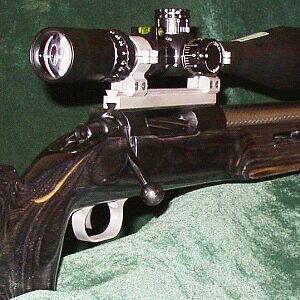 Q: What do you predict for F-Class in the next two to three years in terms of rules changes? Q: What do you predict for F-Class in the next two to three years in terms of rules changes?
In that time frame, I believe definitive rules will be published by the NRA. And we may see shooter classification akin to what is being done now in High-Power shooting (i.e. "Master", "High Master" and so on). The "F Open" class equipment rules will probably be the International Rules. Input from clubs and shooters will determine the "F-TR" equipment but I wouldn't be surprised to see F-TR remain restricted to .223 and .308 caliber.
Q: You've told us that F-Class can be an expensive sport because you're burning through so many 6.5-284 barrels. Is there a solution?
Many of our team members are looking strongly at the 6XC and the DTAC 115gr bullet. They feel they can push the 6mm 115s fast enough to get to the same place ballistically as the 6.5mm 142gr Sierras. From what I've heard we may be able to get a lot more barrel life. A 6.5 barrel shot in F-Class is probably not competitive past 1000 rounds. I think David Tubb won the Long-Range Match at Camp Perry last year with a 6XC barrel with over 2000 rounds through it.
Q: With the barrel life issue being so significant, will the F-Class Team be looking at other chamberings?
In the future I think you'll see a lot fewer U.S. Team members shooting 6.5-284s because of the short barrel life. The most I've ever got was 1300 rounds. I used to think I could get 1000 rounds, but now I think 700-800 rounds is max (my accuracy standard used to be lower). Now a barrel (with 700 rounds) may still be shooting well, but I won't travel across the country to a big match with a barrel with 700 rounds--it's too close to its end life to chance it. You see barrel end life when the group opens with nothing but fouling shots. The barrel is not worn out per se, but it fouls out MUCH more quickly. It may still shoot a tiny 10-round group but it won't do thirty. In the matches ten accurate rounds won't cut it.
Q: Larry Bartholome has told us than F-Class is notable in that it is open to all people, young and old, male and female, even those with disabilities. How important is this to the mission of Team F-Class?
The sport of F-Class was first proposed by a Canadian whose vision problems kept him from using "iron" sights. I also can't see through an aperture sight and we have others with physical disabilities that would prevent them from doing other shooting sports. F-Class is truly a sport everyone can enjoy.
Q: What can be done to keep the costs of F-class shooting at more reasonable levels? Is there a role for a "factory rifle" or a one-design class?
The best way to keep the cost down is not using a "barrel-burner" caliber. Defining a "factory rifle" is a problem. A gun that looks like a factory rifle may have been "blueprinted" with a custom barrel and other enhancements. Match directors shouldn't have to make those decisions or play detective. I really don't know if a one-design rifle class would work in this country--though it does in Europe. Americans like to tinker and customize.
Q: Have you ever been tempted to go with a 6BR Improved case like the Dasher or Bob Crone's BRX?
When competing with my 6BR rifle, I've never felt the need for more case space until the new Tubb 115gr bullet came out. If you want to shoot that bullet I think you do need more boiler room than the 6BR offers, but maybe even a Dasher isn't enough.
Q: Do you think the 6BR will gain in popularity as people recognize its versatility and accuracy for both short and long distances? Or will it remain a specialized chambering for dedicated target shooters?
I think more and people are falling in love with the 6BR as a 300m, 600-yard, F-Class, "over-the-course", or long-range varmint rifle. It is so flexible and easy to load.
Q. For someone building his first F-Class rifle, for club-level competition, what would you recommend?
A 6BR or 6BRX with a quality front rest (not bipod) and rear bag. I'd look for a used short-range Benchrest rifle. Bob White's "List" on Shooters Corner has bargains that may only need a new barrel or not even that if you plan to shoot at 600 yds or under.
Q: Do you have any practice and training advice for new F-Class shooters?
First you have to be able to handle the gun on the bags. Yes, get down and shoot it at short range. Work on addressing the gun the same way every time, and settle on a consistent holding style that works for you. Learn to read the wind. I've said many times, "Once you get your equipment going, it's a wind game." Put up some stakes with engineer tape. This will give you some ideas. Even if you don't hold off for wind, it can help you diagnose what happens with your shot.
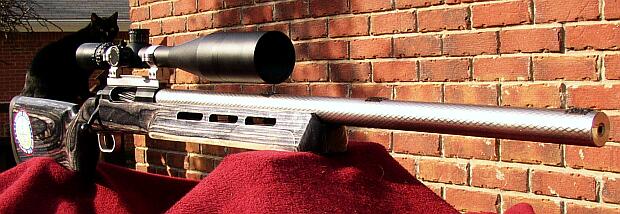
U.S. F-Class Team Gears Up for 2005 World Championship
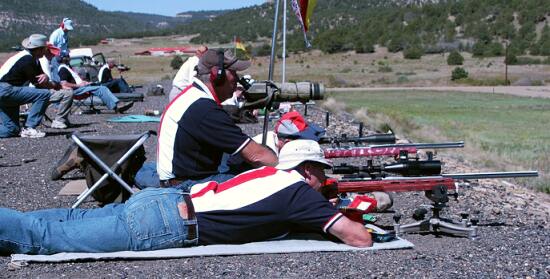
The last time the nations of the world competed for the F-Class Championship, the U.S. Team took top honors. On March 27, the 2005 U.S. F-Class Team members will board a flight to South Africa to defend their title. Shooting activities begin in Bloemfontein on the 29th, with Provincial matches. Some Team members may participate in these regional shoots to tune-up and learn the conditions at the General De Wit range. Scouting the wind will be key to a successful match according to Team coaches. All Team members will shoot 6.5-284s with 142 SMKs so consistent wind calls can be made for all shooters. John Brewer explains: "In South Africa, the individual matches will be shot three to a mound. Three shooters will be laying side-by-side with one taking a shot, another scoring him and the third getting ready to shoot. All at the same target! The wind has time to change several times between your shots, so this is the ultimate test in a wind-reading."
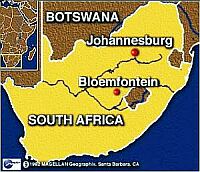 After the Regional matches, on April 11, team members, including John Brewer, will compete head to head in the two-day individual trophy match at distances of 700m, 800m, and 900m. The course of fire will be two sighters and 15 for score on the 11th, plus two sighters and 20 for score on the 12th. With no rest for the weary, the Team Competition kicks off the next day, April 13. Team USA will field a squad of eight shooters, plus coaches and team captain, to compete for the world team title on the 13th and 14th. (The course of fire duplicates the individual matches, but with two sighters and 15 for score on both days.) Hopefully our American team will once again emerge victorious. After the Regional matches, on April 11, team members, including John Brewer, will compete head to head in the two-day individual trophy match at distances of 700m, 800m, and 900m. The course of fire will be two sighters and 15 for score on the 11th, plus two sighters and 20 for score on the 12th. With no rest for the weary, the Team Competition kicks off the next day, April 13. Team USA will field a squad of eight shooters, plus coaches and team captain, to compete for the world team title on the 13th and 14th. (The course of fire duplicates the individual matches, but with two sighters and 15 for score on both days.) Hopefully our American team will once again emerge victorious.
The U.S. F-Class Rifle Team, is a group of dedicated very-long-range shooters, who banded together to win the first World F-Class Championship in August 2002. The International Team consisted of a team captain, a team manager, a central coach, two firing point coaches, eight firing members and two alternates. The team traveled to the Connaught Ranges just outside Ottawa, Canada, to compete in individual and team matches at 700, 800 and 900 meters. The U.S. team dominated the matches with wins in both team matches, against outstanding rivals from Germany, England, Australia, South Africa and Canada. Team members also placed second, third, fourth and sixth in the individual competitions.
What is F-Class?
This relatively new shooting sport is shot prone at distances of 300 to 1,000 yards. Competitors may use almost any caliber rifle, a scope, and a front and rear rest or bipod. F-Class popularity is growing by leaps and bounds around the globe. F-Class shooters use the same targets as (and often shoot concurrently with) the world's long-range Palma shooters. This compatibility is important because match promoters do not need additional resources to include F-Class in their programs.
This shooting discipline is something anyone can try, even those with little long-range shooting experience. F-Class is an ideal sport for beginning competitive shooters, both male and female.
F-Class is already the fastest growing long-range shooting sport in the world, and it is sure to continue growing as more and more people become familiar with its unique challenges.
How Can We Support the U.S. Team?
For more information on the U.S. F-Class team, visit USFClass.com. The site contains a wealth of information. Though the World Championship is coming up very soon, the U.S. Team still welcomes contributions to the effort. It takes significant resources to field a full team, and many of the shooters have had to dig deep into their own pockets to participate with the squad.
Tax exempt contributions may be made to the U.S. F-Class Rifle Team through Palma Promotions. Palma Promotions, Inc. was founded in 1993 as a volunteer, non-profit organization (specifically, an IRS certified non-profit, 501(c)(3), Amateur Sports Organization) with the sole purpose to foster and promote National and International Long Range Rifle competition and to create an increased awareness of this world-class sport.
Send Donations to:
U.S. F-Class Rifle Team
P.O. Box 372307
El Paso, TX 79937-2307
Or Contact:
Larry Bartholome, Team Captain | 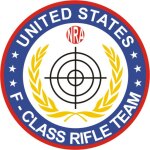 |
|
Did You Enjoy Reading this Article? If So, You Can Help Support
6mmBR.com by Making a Small, Secure Contribution.
U.S. F-Class Team photos, Copyright © 2005, Mary Fuqua/Jon Cowee, All Rights Reserved. Rifle photos by John Brewer. All other content Copyright © 2005, 6mmBR.com, All Rights Reserved. No reproduction of any content without advanced permission in writing.
Topics: 6mm, 6mm BR, 6BR, 6.5, 6.5mm, 6.5-284, 6PPC, F-Class, USA, U.S. F-Class Team, Lilja, Krieger, Schneider, 1000 yards, IBS, NBRSA, "F" Class, TR, Target Rifle, Jewell trigger, Benchrest, BR, Bench Rest, Single-shot, competition, rifle accuracy, Wind, BC, Ballistics, Norma, Hodgdon Powder, Varget, Vihtavuori, N150, N540, Lapua Scenar, Sierra, MatchKing, Competition Shooting, Stocks, Shehane, Tracker, MBR, Kelbly, Stolle Action, Panda, stainless barrel, reloading, powder, case forming, neck-turning, Lapua Brass, bullets, precision, Bloemfontein, South Africa.


|